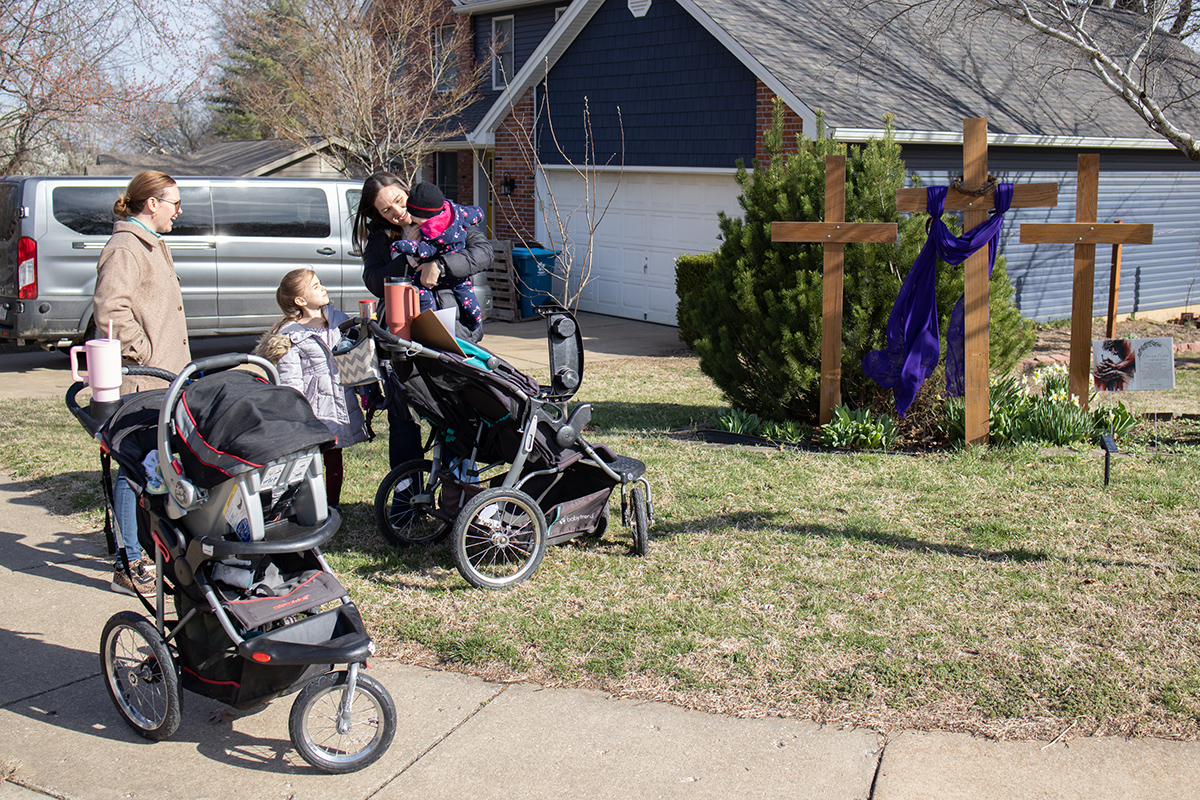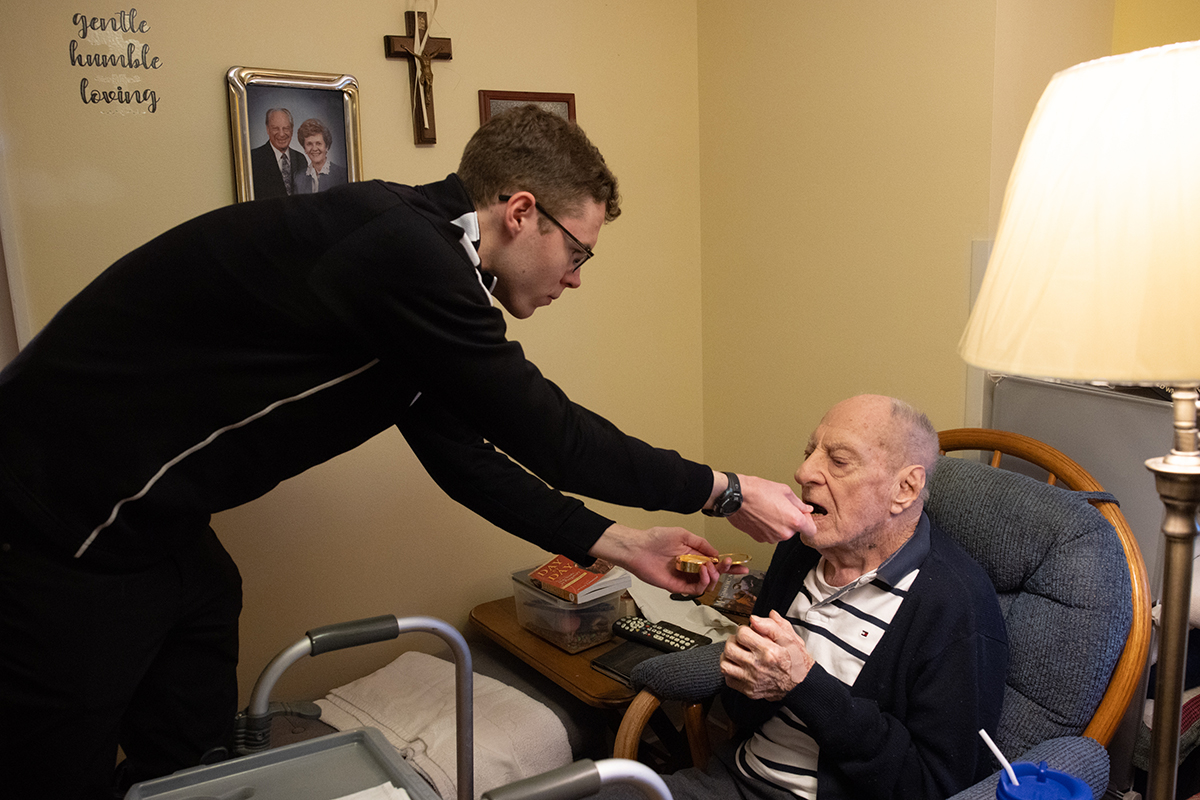Advent: A time for patient waiting

COVID-19’s impact on the rush-rush of our culture ties to the meaning of Advent
The Advent Season reminds us to wait and be ever watchful for our God, who comes to us in the ordinary circumstances of life. Waiting is a struggle for many people as we see today with COVID-19 pandemic and the wait that we have for it to be over as well as the desire to stop taking precautions.
Patient waiting is the key to a good Advent. But it is hard to do in a culture that tells us to rush ahead. “Blessed are all who wait for the Lord,” the prophet Isaiah says. Isaiah is looking forward to the day of the Lord and teaching us to wait for it with expectation.
The word “Advent” comes from the Latin word for “to come.” St. John Henry Newman reminded us in a homily for the Advent season: “Advent is a time of waiting, it is a time of joy because the coming of Christ is not only a gift of grace and salvation but it is also a time of commitment because it motivates us to live the present as a time of responsibility and vigilance. This ‘vigilance’ means the necessity, the urgency of an industrious, living ‘wait.’”
Anticipation

Advent has themes for each of the four Sundays. It starts with End Times and has two Sundays with St. John the Baptist and ends with St. Mary and her anticipation of the birth of Jesus.
“We wait on the Lord in two different dimensions,” said Dominican Father Mark Wedig. “One is the final anticipation, the final waiting; and then the more immediate waiting that comes with the birth of Christ in the Christmas season.”
COVID-19 has made people wait on “what comes after this, what comes about because of this. But also waiting on what counteracts or mitigates the anxiousness and very often the lack of patience that exists in all of our lives, the instantaneous kind of world we live in,” he said.
The readings for Advent follow the levels of anticipation as the weekday cycle of readings continue. “That rich biblical thematic helps us to awaken our imagination to the meanings of Advent,” Father Wedig said.
People also are asked to pay attention to how Isaiah calls people to recognize the need for God and how John the Baptist challenges people to a way of living that anticipates the Lord. It’s also a call to anticipate a time of peace and justice in God’s kingdom.
Advent also is a season of hope, mitigating the despair of our world which brings anxiousness and the failure to be patient. “How God’s love for us becomes manifest in human flesh, bearing the human condition, gives us great hope,” Father Wedig said. Failure to hope in God’s promises in our lives brings despair.
Father Wedig is president and professor of liturgical theology at Aquinas Institute of Theology in St. Louis
Slow down

Father John Johnson said that the COVID-19 pandemic and restrictions on activities can be considered a time to make Advent what it’s supposed to be.
“We are, because of necessity, sort of living in a different atmosphere. Socializing, getting together for parties is pretty much out of the question right now. Running around doing so many things we usually do during this season is totally different from what we should be doing for ourselves from a health and welfare standpoint,” he explained.
Many people have problems with slowing down. Some get addicted to substances or lost in other pursuits. “There’s all kinds of things people will use as a substitute that can be rather dangerous,” Father Johnson said. “I think the goal should be to turn this time into a kind of retreat time. A time to stop doing what we usually do, settling down and actually being quiet so we can wait on God, which is one definition people have for prayer, which is waiting, waiting for God.”
Matthew’s Gospel (25: 1-13) for the 32nd Sunday in Ordinary Time, Nov. 8, tells Jesus’ parable of the women waiting for the bridegroom, with the wise ones ready when he came and the foolish ones, who hadn’t been prepared, hurrying to buy oil for their lamps. When the bridegroom arrived, they weren’t there but the wise ones were still waiting for him.
Father Johnson related that reading to how Advent can help with the wait for the pandemic to end: “It gives us a view of how we can turn what many people are calling a very difficult, painful experience and turning it into something very spiritual and meaningful.”
Another time like this may not come along again for us, he said, “so if we just use this time wisely, then we will become more aware of God in our lives, and it becomes four weeks of listening and being quiet, focusing on what matters most, that is the presence of Jesus.”
Father Johnson recommends meditating on the Scriptures during Advent and focusing on the presence of the Lord. “We want to be ready and be focused when He comes.”
He refers to the last part of Matthew’s Gospel of the Parable of the 10 Virgins: “Afterward the other virgins came and said, ‘Lord, Lord, open the door for us!’ But he said in reply, ‘Amen, I say to you, I do not know you.’ Therefore, stay awake, for you know neither the day nor the hour.”
Father Johnson is a retired parish pastor in residence at St. Justin Martyr Parish in Sunset Hills.
>> Prepare our hearts
Advent links the first and second comings of Christ. It points us to Christmas and helps us to prepare to celebrate the birth of Jesus and to open our hearts to receive Him daily.
Consider adopting these Advent practices:
• Light the candles of Advent wreaths each Sunday of the season
• Go to confession.
• Attend spiritual gatherings.
• Reach out to the poor and vulnerable.
• Look to Isaiah, a great figure of Advent and the prophet of hope for God’s people. When God’s people were mired in doubt and confusion during their exile, Isaiah provided a promise of a time to come that will restore their relationship with God.
>> Resources
• Archdiocese of St. Louis’ Advent page at archstl.org/joy
• The U.S. Conference of Catholic Bishops’ materials include a reflection on “Advent: A Time of Waiting, Conversion and Hope.” Visit catholiccurrent.org/resources-for-advent.
• St. Louis Review Advent stories: www.archstl.org/st-louis-review/advent.
• The Catholic Health Association offers spiritual resources appropriate for waiting during the COVID-19 pandemic. Included are meditative reflections and prayers. Visit bit.ly/2UeSbsL.
>> Traditions to usher in the birth of Christ
THE ADVENT WREATH
Although the Advent Wreath is not an official part of the Church’s Sunday liturgies, it does enjoy the status of a venerable custom.
The wreath, without beginning or end, stands for eternity. The greens represent life and growth. The four candles (traditionally three purple and one rose) represent the ages sitting in darkness, each candle adding more light until Christmas and the dawn of the light of Christ. Ideally, the first candle to be lit is opposite the rose candle, since that will be lit on the Third Sunday of Advent. We also call that Sunday “Gaudete Sunday,” since the word “rejoice” is used in the opening antiphon for Mass that day (see Philippians 4:4-5).
The blessing of the Advent Wreath takes place on the First Sunday of Advent (or its vigil Mass). On successive Sundays, the candles are lit before Mass or before the Opening Prayer without additional rites or prayers (Book of Blessings nos. 1509-1514, 1519, 1526)
In the home, the wreath may be placed on the dining table or other convenient place. Family members may take turns lighting the candles on successive Sundays.
THE JESSE TREE
The Jesse Tree is an Advent tradition that recalls Jesus’ family lineage. The tree of Jesse was a common subject in medieval and early Renaissance art representing the royal genealogy of Christ from Jesse, the father of David. The image of the tree was taken from Isaiah 11:1, “But a shoot shall sprout from the stump of Jesse and from his roots a bud shall blossom.”
The shoot has been interpreted as the Blessed Virgin Mary and the blossom as her Son, Jesus Christ. There are many online sources for ornament templates. When making the tree, look for symbols that can represent important people or events in Christ’s life or in the Old Testament. The tree can be made out of many things; you can use an actual tree limb, or it can be made on a piece of felt or fabric. All family members can help create the symbols. They can be placed all at once, or placed ceremoniously each day of Advent. It is suggested that you make them out of sturdy materials so that they can be used from year to year.
Jesse Tree resources:
• Domestic-Church.com has some Jesse Tree inspiration, including corresponding images and Bible verses and inspiration for making a tree and ornaments. Author Catherine Fournier also has a book, “The Jesse Tree: A Family Craft for Advent.”
• Catholic blogger Jessica from Shower of Roses has a tutorial for making a no-sew Jesse Tree and ornaments from felt.
• “The Jesse Tree” (Geraldine McCaughrean), is a children’s book that traces Jesus’ family tree.
• The Advent Jesse Tree” (Dean Lambert Smith) includes devotions for children and adults to prepare for the birth of Jesus.
Source: Federation of Diocesan Liturgical Commissions
The Advent Season reminds us to wait and be ever watchful for our God, who comes to us in the ordinary circumstances of life. Waiting is a struggle for many … Advent: A time for patient waiting
Subscribe to Read All St. Louis Review Stories
All readers receive 5 stories to read free per month. After that, readers will need to be logged in.
If you are currently receive the St. Louis Review at your home or office, please send your name and address (and subscriber id if you know it) to subscriptions@stlouisreview.com to get your login information.
If you are not currently a subscriber to the St. Louis Review, please contact subscriptions@stlouisreview.com for information on how to subscribe.







